Dermal Fillers
Vancouver
Get a Fresh Look with Dermal Fillers at EverYoung Skin Care Clinic in Vancouver
Erase the signs of aging and enhance facial features for a youthful look without surgery.
Dermal fillers are one of the most dramatic means of reversing the signs of aging, enhancing facial features, and restoring balance through facial sculpting. Our talented physician injectors are known for their artistic vision; often surprising our patients with results that exceed their expectations.
Wrinkles and Lines:
Using hyaluronic acid, a natural substance found in the human body, dermal fillers plump skin depressions to create a smooth, light reflective surface that is youthful and flattering. Effective on lines, wrinkles, creases, furrows, hollows and indentations, dermal fillers ease the expression lines that make us appear angry or sad; resulting in a refreshed, more beautiful appearance.
Facial Volume:
Cosmetic filler is the most effective means of restoring volume to faces or hands that have deflated or lost fat because of aging. It is used to “plump” the skin, and when placed strategically—creates a “lifting” effect for a naturally younger appearance. When combined with Botulinum Toxin, a non-surgical facelift is achieved for ultimate West Vancouver facial filler rejuvenation.
Facial Sculpting:
Our cosmetic doctors, Dr. Zheng and Dr. Yam are known for their talent in facial sculpting; providing non-surgical enhancement or augmentation of the nose, cheeks, lips, chin, temples jawline and under-eye hollows to beautify your appearance or correct asymmetries.
At EverYoung, our cosmetic doctors will improve your appearance while maintaining a natural, beautiful result that is never overdone. We invite you to book a consultation and view the many examples of cosmetic transformations performed in our Medspa Clinics in Port Coquitlam, North Vancouver and Burnaby.
Acne Scar Filler
Are you tired of battling stubborn acne scars that seem to linger long after breakouts have cleared? Bellafill fillers offer a revolutionary solution. Unlike temporary treatments that merely camouflage scars, Bellafill provides results lasting 5 to 10 years, by stimulating your own collagen production, effectively filling in depressions caused by acne scars. With its unique formula consisting of microspheres suspended in PMMA in the collagen matrix, Bellafill offers immediate improvement while promoting long-term collagen growth, ensuring a smoother, more youthful complexion. Say goodbye to the frustration of concealers and hello to the confidence that comes with smooth, radiant skin. Experience the transformative power of Bellafill and reclaim your skin’s natural beauty.
See: Lip Enhancement, Non-Surgical Facelift, Non-Surgical Nose Job, Cheek, Chin and Jawline Enhancement and Hand Rejuvenation
Before & After Shots
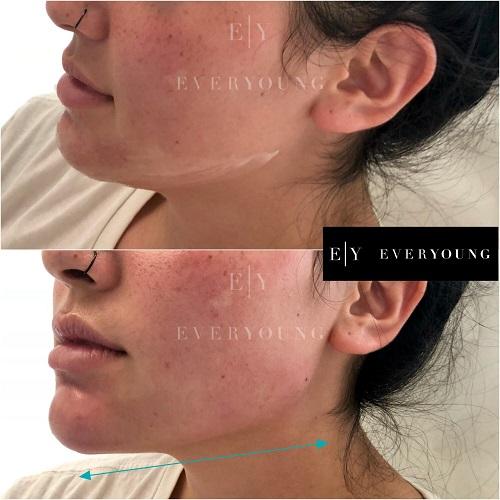



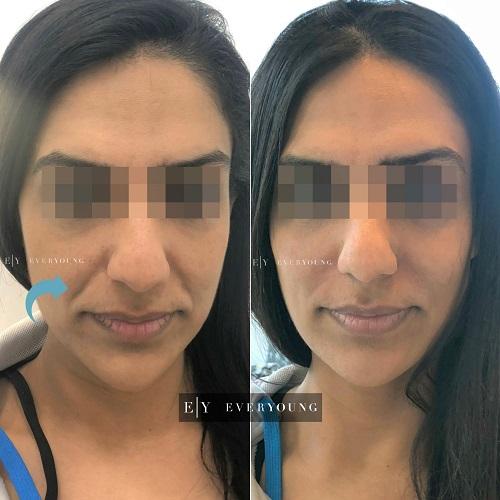
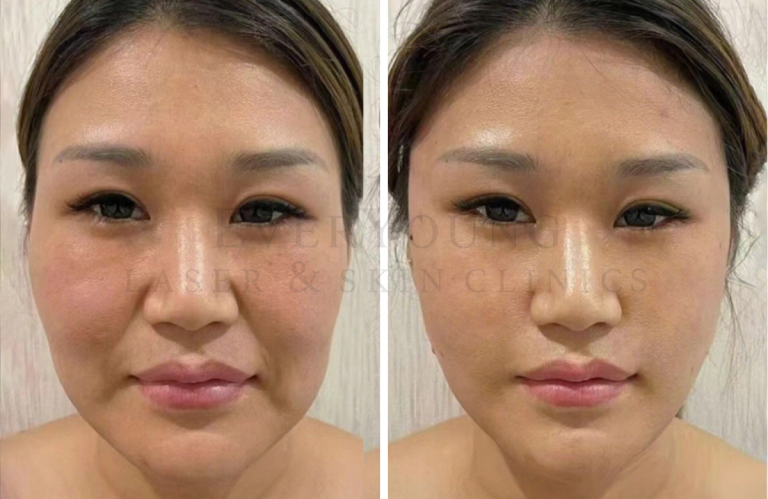
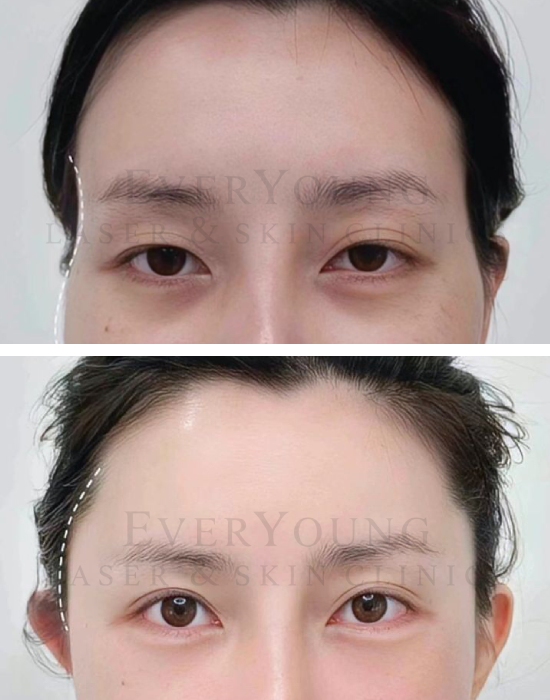
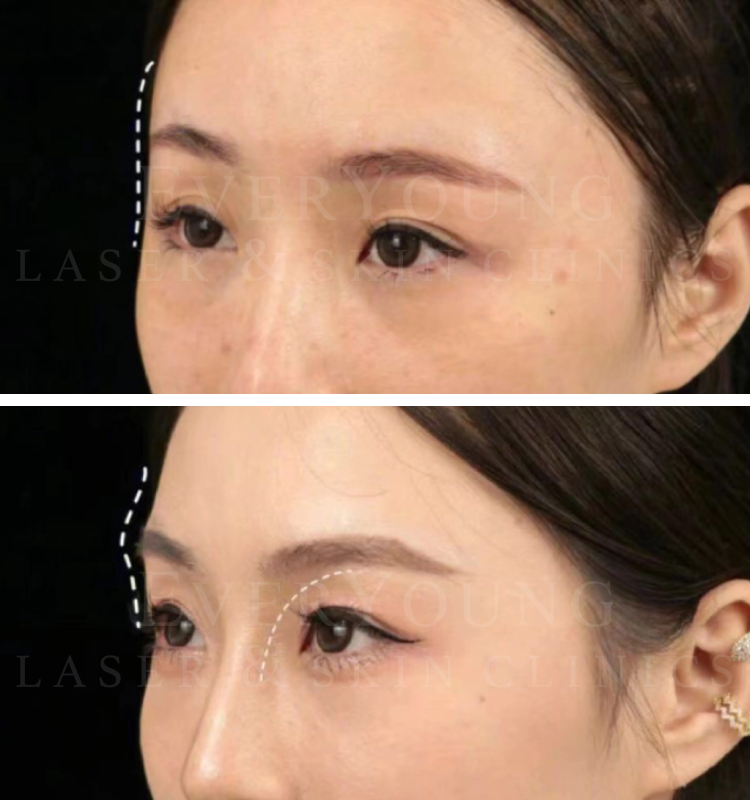
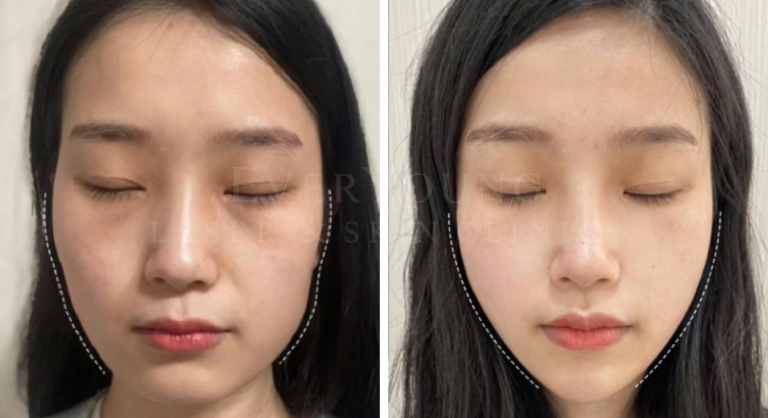
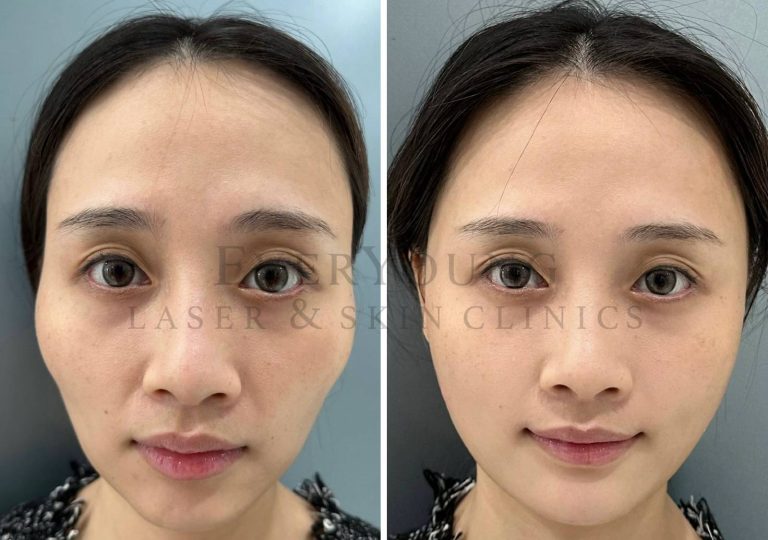
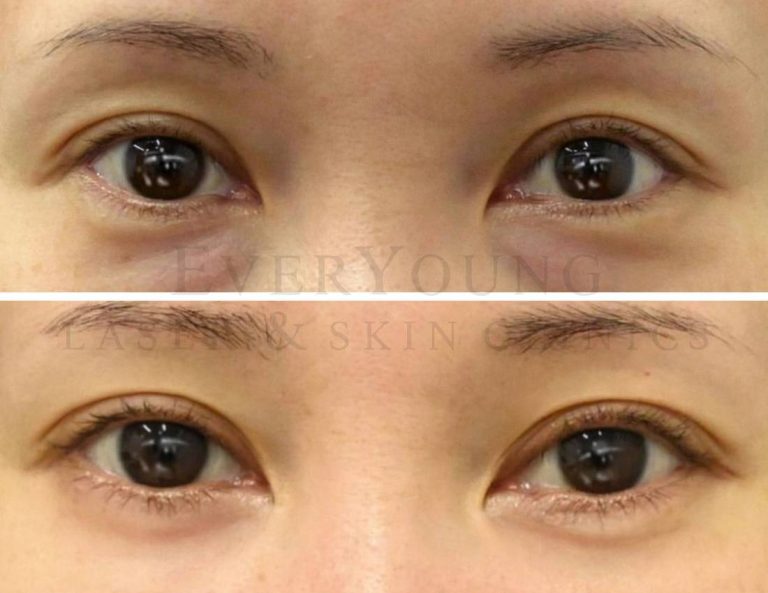
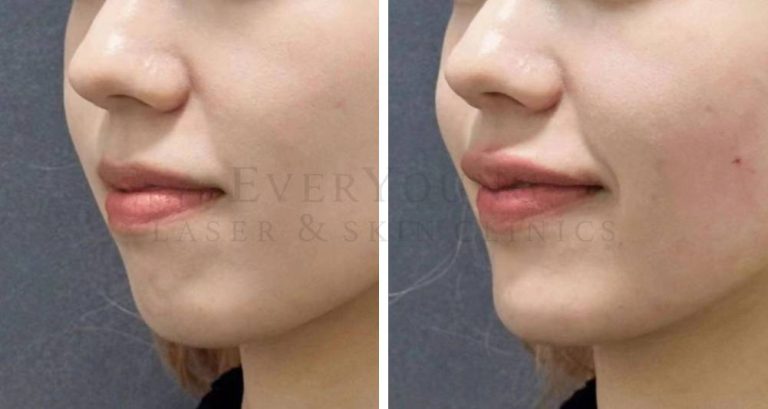
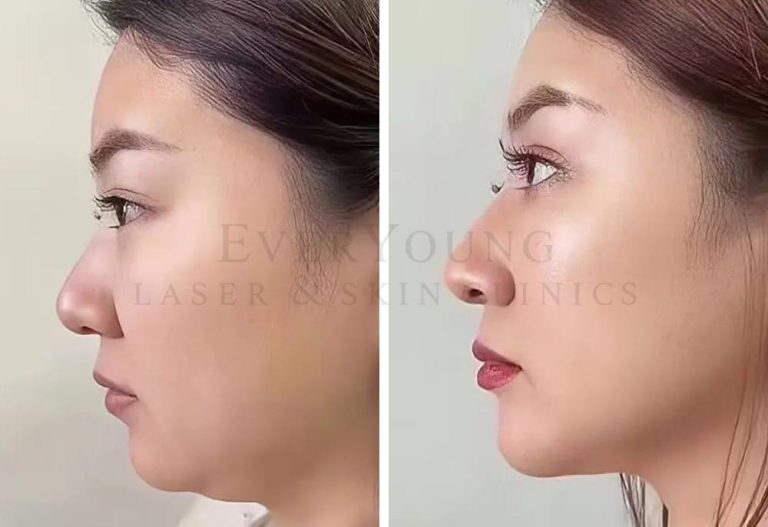
Treatments at a Glance

One treatment

9-12+ months

None

Results
One treatment

of Results
9-12+ months

None

Low

Low

30 Minutes

Right away

Time
30 Minutes

Work
Right away
Benefits of Dermal Filler Treatments









Treatable Areas













Types of Fillers
At EverYoung Medical Aesthetics, we carry every FDA-approved dermal filler (also known as wrinkle filler or soft tissue filler), available in Canada to provide you with the perfect product to obtain your desired results.
Juvederm / Juvederm Voluma XC / Juvederm Vobella / Juvederm Volift / Juvederm Ultra / Juvederm Ultra Plus / Radiesse / Teosyal / Teosyal PureSense redensity / Teosyal Ultra Deep / Teosyal Ultimate / Teosyal Kiss / Restylane / Restylane Fine lines / Perlane / Sculptra / BellaFill / Belkyra / Belotero / Belotero Hydro / Belotero soft / Belotero Balance / Belotero Intense / Belotero Volume / Belotero Ultra / Revanesse / Revanesse Contour / Revanesse Kiss / Revanesse Pure
FAQ
Yes. All of the cosmetic dermal fillers carried at EverYoung are FDA and Health Canada approved for safety and efficacy. Most Dermal fillers are composed of Hyaluronic Acid, a naturally occurring component of the epidermis that contributes to skin structure, tone and hydration. Please book a consultation with one of our medical physicians to learn which soft tissue filler is right for you.
Depending on the type of filler recommended by your cosmetic physician, the effects can last anywhere from six months to two years. Semi-permanent or permanent fillers may last up to eight years, and in some instances, even longer.
Results are instantaneous. While some swelling or redness is to be expected, and occasional bruising may occur, the line smoothing and plumping effects of soft tissue fillers are immediately visible. Over the course of the first week, you will see the full effects of the treatment.
The duration of filler results in acne scars can vary, but it typically lasts anywhere from 6 to 18 months or longer, depending on the type of filler used and individual factors.
Getting filler in acne scars is an option to improve their appearance, but it’s a personal decision that should be discussed with a dermatologist or cosmetic surgeon to determine if it’s the right treatment for your specific scars and goals.
The downtime for acne scar fillers is typically minimal, with possible temporary redness, swelling, or bruising that can last a few days, but you can generally resume normal activities immediately after the procedure.
Scar fillers are not permanent; the duration of their effects can vary depending on the type of filler used, but they typically last from several months to a couple of years.
The healing time for acne scar treatment can vary depending on the specific procedure used, but it often ranges from a few days to a few weeks, with continued improvement over several months as collagen remodeling occurs.
Filler can soften the appearance of scar tissue by adding volume to the area, but it does not break down the scar tissue itself.
Fillers can improve the appearance of scars by filling in depressions and making them less noticeable, but they do not completely remove scars.
Fillers do not directly affect acne, as they are used to address the appearance of scars or wrinkles, but some individuals may experience temporary mild acne-like reactions at the injection sites.
Yes, fillers gradually fade away over time as the body naturally metabolizes the filler material, and the duration of their effects varies depending on the type of filler used.
Filler materials are typically not permanent and can eventually be metabolized by the body, so they usually do not stay in the face forever.
Dermal fillers, such as hyaluronic acid fillers, can help hide the appearance of scars by filling in depressions and making them less noticeable.
It is possible to develop a pimple or small breakout at the filler injection site, although it is relatively uncommon and typically temporary.
The duration of scar fillers can vary depending on the type of filler used, but it typically ranges from 6 months to 2 years or more.
Permanent fillers carry a higher risk of long-term complications and are generally less preferred by many healthcare providers due to potential safety concerns.
When filler is removed, either through a reversal procedure or over time as it naturally breaks down, the treated area returns to its previous appearance.
After filler treatment, the treated area typically appears smoother, plumper, and rejuvenated, addressing concerns such as wrinkles, volume loss, or scars.
When you stop using fillers, the treated areas gradually return to their pre-filler appearance, as the filler material is gradually metabolized by the body.
The permanence of filler depends on the type of filler used; some fillers are temporary and last several months to a few years, while others are more long-lasting but still not permanent.
Fillers may not work as expected if they are not properly administered or if the chosen filler is not appropriate for the specific concern, or if the individual has unrealistic expectations.
Filler movement after several months is uncommon but can occur if the filler was not evenly distributed during the initial injection or if there is manipulation or pressure on the treated area.
You can typically sleep on your face after fillers once any initial swelling and tenderness have subsided, which may take a few days to a week, but it’s best to follow your healthcare provider’s specific post-treatment instructions.
Fillers should not be injected near the eyes or temples to avoid potential complications such as swelling, lumps, or damage to blood vessels. Additionally, injecting fillers in areas with a high risk of infection, such as the nose or around the mouth, should be approached with caution to prevent adverse reactions.
Individuals with a history of severe allergies, autoimmune disorders, or certain skin conditions may not be good candidates for fillers due to an increased risk of adverse reactions. Pregnant or breastfeeding women should also avoid fillers, as the safety of these treatments in such situations has not been conclusively established.
Signs that filler has gone wrong may include uneven or lumpy results, excessive swelling, bruising, or discoloration. If there is persistent pain, infection, or skin changes at the injection site, it’s essential to consult with a healthcare professional promptly to address potential complications.
You should be worried about fillers if you experience severe or prolonged swelling, persistent pain, noticeable asymmetry, or if there are signs of infection such as redness, warmth, or discharge at the injection site. Seeking immediate medical attention is crucial if you encounter any of these issues or if you have concerns about the outcome of the filler treatment.
The amount of filler needed over time can vary among individuals, and it is not necessarily the case that you need less filler as time progresses. Factors such as aging, lifestyle, and individual responses to filler treatments will influence the maintenance and adjustments required, and a personalized approach with a qualified healthcare professional is essential for determining the appropriate amount of filler for each session.
Cheek fillers typically start to show immediate results, but it may take a week or two for them to fully settle as any initial swelling or bruising subsides. Patients are advised to follow post-procedure care instructions and allow a few weeks for the final, natural-looking outcome to be evident.
The choice of filler for a natural look depends on individual preferences and the specific area being treated. Hyaluronic acid fillers, such as Juvederm or Restylane, are often favored for their ability to provide subtle and natural-looking results, as they closely resemble the body’s own hyaluronic acid. Consulting with a qualified healthcare professional can help determine the most suitable filler based on your aesthetic goals and unique facial features.
A temporary “weird” appearance after fillers could be due to post-injection swelling or bruising, which usually subsides within a week or two. However, if you’re unhappy with the results, it’s crucial to communicate your concerns with the healthcare professional who administered the fillers to discuss any potential adjustments or solutions.
After fillers, it’s important to avoid strenuous activities, excessive heat or cold exposure, and alcohol consumption for the first 24-48 hours. Additionally, follow any specific post-procedure instructions provided by your healthcare professional, such as applying ice to reduce swelling and avoiding certain medications that may increase the risk of bruising.
Fillers containing hyaluronic acid can be dissolved faster with the injection of hyaluronidase, an enzyme that breaks down hyaluronic acid. Additionally, factors such as metabolism, individual response to the filler, and the type of filler used can influence the speed at which fillers naturally break down over time.
The frequency of filler treatments depends on individual factors such as metabolism, the type of filler used, and personal aesthetic goals. On average, most people choose to have filler injections every 6 to 18 months to maintain the desired results. However, it’s essential to consult with a qualified healthcare professional to create a personalized plan based on your specific needs and the characteristics of the chosen filler.
While staying hydrated is essential for overall skin health, drinking water does not directly affect the longevity or performance of fillers. The effectiveness and duration of fillers are primarily influenced by factors such as the type of filler used, individual metabolism, and proper aftercare, rather than hydration alone.
It’s generally advisable to avoid touching your face directly after fillers to minimize the risk of infection or irritation. Follow the specific post-procedure instructions provided by your healthcare professional, which may include gentle care and avoiding pressure on the treated areas for a certain period to ensure optimal results and safety.
Swelling after fillers varies among individuals, but it commonly subsides within a few days to a week, with complete resolution depending on factors like the type of filler used and the specific treatment area.
First-time filler recipients can expect initial swelling and possible bruising, but these effects typically diminish within a week, revealing the full, natural-looking results of the treatment.
Immediately after filler, there may be some swelling, redness, or bruising, but these temporary effects usually subside within a few days, leaving a more refreshed and enhanced facial appearance.
There’s no need to avoid smiling after filler, but it’s advisable to be mindful of facial expressions and avoid excessive movement in the treated areas for the first day or two to minimize potential swelling or bruising.
After fillers, it’s advisable to avoid hot beverages and alcohol for the first 24 hours to minimize the risk of increased swelling or bruising.
Over time, fillers gradually break down and are absorbed by the body, leading to a natural, gradual return to the pre-treatment state.
No, fillers are designed to be stable and typically do not move easily after injection, adhering to the targeted treatment area.
The ideal age to get filler varies for each individual, but many people consider it in their late twenties to mid-thirties and beyond, as signs of aging become more noticeable.
While fillers primarily address volume loss and wrinkles, they may indirectly improve skin quality by promoting hydration and stimulating collagen production in the treated areas.
The lifespan of fillers varies depending on the type used, but most hyaluronic acid fillers last from six months to two years before the body gradually absorbs them.
Fillers can be strategically used to contour and enhance facial features, contributing to a more sculpted appearance that may create the illusion of a slimmer face.
Fillers can sometimes create a shiny appearance due to light reflection on the smoother surface of the treated skin, but this effect is temporary and typically resolves as the initial swelling subsides.
DERMAL FILLERS FAQ
Yes. All of the cosmetic dermal fillers carried at EverYoung are FDA and Health Canada approved for safety and efficacy. Most Dermal fillers are composed of Hyaluronic Acid, a naturally occurring component of the epidermis that contributes to skin structure, tone and hydration. Please book a consultation with one of our medical physicians to learn which soft tissue filler is right for you.
Depending on the type of filler recommended by your cosmetic physician, the effects can last anywhere from six months to two years. Semi-permanent or permanent fillers may last up to eight years, and in some instances, even longer.
Results are instantaneous. While some swelling or redness is to be expected, and occasional bruising may occur, the line smoothing and plumping effects of soft tissue fillers are immediately visible. Over the course of the first week, you will see the full effects of the treatment.
After dermal filler injections, it’s important to avoid strenuous exercise, excessive sun or heat exposure, and alcohol consumption for the first 24 hours, while also following any specific post-treatment instructions provided by the practitioner.
The number of sessions for dermal fillers varies based on individual goals and the specific area treated, but visible results are often achieved with a single session, and additional sessions may be scheduled for optimal outcomes.
Dermal fillers tend to last the longest in areas with minimal muscle movement, such as the cheeks, where the product experiences less breakdown due to reduced dynamic forces.
Yes, you can moisturize your face after fillers, but it’s recommended to use a gentle, non-irritating moisturizer and avoid massaging or rubbing the treated areas.
Yes, fillers can enhance and rejuvenate facial features, providing subtle or more noticeable changes to one’s appearance, depending on individual goals and preferences.
ACNE SCAR FILLER FAQ
The duration of filler results in acne scars can vary, but it typically lasts anywhere from 6 to 18 months or longer, depending on the type of filler used and individual factors.
Getting filler in acne scars is an option to improve their appearance, but it’s a personal decision that should be discussed with a dermatologist or cosmetic surgeon to determine if it’s the right treatment for your specific scars and goals.
The downtime for acne scar fillers is typically minimal, with possible temporary redness, swelling, or bruising that can last a few days, but you can generally resume normal activities immediately after the procedure.
Scar fillers are not permanent; the duration of their effects can vary depending on the type of filler used, but they typically last from several months to a couple of years.
The healing time for acne scar treatment can vary depending on the specific procedure used, but it often ranges from a few days to a few weeks, with continued improvement over several months as collagen remodeling occurs.
Filler can soften the appearance of scar tissue by adding volume to the area, but it does not break down the scar tissue itself.
Fillers can improve the appearance of scars by filling in depressions and making them less noticeable, but they do not completely remove scars.
Fillers do not directly affect acne, as they are used to address the appearance of scars or wrinkles, but some individuals may experience temporary mild acne-like reactions at the injection sites.
Yes, fillers gradually fade away over time as the body naturally metabolizes the filler material, and the duration of their effects varies depending on the type of filler used.
Filler materials are typically not permanent and can eventually be metabolized by the body, so they usually do not stay in the face forever.
Dermal fillers, such as hyaluronic acid fillers, can help hide the appearance of scars by filling in depressions and making them less noticeable.
It is possible to develop a pimple or small breakout at the filler injection site, although it is relatively uncommon and typically temporary.
The duration of scar fillers can vary depending on the type of filler used, but it typically ranges from 6 months to 2 years or more.
Permanent fillers carry a higher risk of long-term complications and are generally less preferred by many healthcare providers due to potential safety concerns.
When filler is removed, either through a reversal procedure or over time as it naturally breaks down, the treated area returns to its previous appearance.
After filler treatment, the treated area typically appears smoother, plumper, and rejuvenated, addressing concerns such as wrinkles, volume loss, or scars.
When you stop using fillers, the treated areas gradually return to their pre-filler appearance, as the filler material is gradually metabolized by the body.
The permanence of filler depends on the type of filler used; some fillers are temporary and last several months to a few years, while others are more long-lasting but still not permanent.
Fillers may not work as expected if they are not properly administered or if the chosen filler is not appropriate for the specific concern, or if the individual has unrealistic expectations.
Filler movement after several months is uncommon but can occur if the filler was not evenly distributed during the initial injection or if there is manipulation or pressure on the treated area.
You can typically sleep on your face after fillers once any initial swelling and tenderness have subsided, which may take a few days to a week, but it’s best to follow your healthcare provider’s specific post-treatment instructions.
Fillers should not be injected near the eyes or temples to avoid potential complications such as swelling, lumps, or damage to blood vessels. Additionally, injecting fillers in areas with a high risk of infection, such as the nose or around the mouth, should be approached with caution to prevent adverse reactions.
Individuals with a history of severe allergies, autoimmune disorders, or certain skin conditions may not be good candidates for fillers due to an increased risk of adverse reactions. Pregnant or breastfeeding women should also avoid fillers, as the safety of these treatments in such situations has not been conclusively established.
Signs that filler has gone wrong may include uneven or lumpy results, excessive swelling, bruising, or discoloration. If there is persistent pain, infection, or skin changes at the injection site, it’s essential to consult with a healthcare professional promptly to address potential complications.
You should be worried about fillers if you experience severe or prolonged swelling, persistent pain, noticeable asymmetry, or if there are signs of infection such as redness, warmth, or discharge at the injection site. Seeking immediate medical attention is crucial if you encounter any of these issues or if you have concerns about the outcome of the filler treatment.
The amount of filler needed over time can vary among individuals, and it is not necessarily the case that you need less filler as time progresses. Factors such as aging, lifestyle, and individual responses to filler treatments will influence the maintenance and adjustments required, and a personalized approach with a qualified healthcare professional is essential for determining the appropriate amount of filler for each session.
Cheek fillers typically start to show immediate results, but it may take a week or two for them to fully settle as any initial swelling or bruising subsides. Patients are advised to follow post-procedure care instructions and allow a few weeks for the final, natural-looking outcome to be evident.
The choice of filler for a natural look depends on individual preferences and the specific area being treated. Hyaluronic acid fillers, such as Juvederm or Restylane, are often favored for their ability to provide subtle and natural-looking results, as they closely resemble the body’s own hyaluronic acid. Consulting with a qualified healthcare professional can help determine the most suitable filler based on your aesthetic goals and unique facial features.
A temporary “weird” appearance after fillers could be due to post-injection swelling or bruising, which usually subsides within a week or two. However, if you’re unhappy with the results, it’s crucial to communicate your concerns with the healthcare professional who administered the fillers to discuss any potential adjustments or solutions.
After fillers, it’s important to avoid strenuous activities, excessive heat or cold exposure, and alcohol consumption for the first 24-48 hours. Additionally, follow any specific post-procedure instructions provided by your healthcare professional, such as applying ice to reduce swelling and avoiding certain medications that may increase the risk of bruising.
Fillers containing hyaluronic acid can be dissolved faster with the injection of hyaluronidase, an enzyme that breaks down hyaluronic acid. Additionally, factors such as metabolism, individual response to the filler, and the type of filler used can influence the speed at which fillers naturally break down over time.
The frequency of filler treatments depends on individual factors such as metabolism, the type of filler used, and personal aesthetic goals. On average, most people choose to have filler injections every 6 to 18 months to maintain the desired results. However, it’s essential to consult with a qualified healthcare professional to create a personalized plan based on your specific needs and the characteristics of the chosen filler.
While staying hydrated is essential for overall skin health, drinking water does not directly affect the longevity or performance of fillers. The effectiveness and duration of fillers are primarily influenced by factors such as the type of filler used, individual metabolism, and proper aftercare, rather than hydration alone.
It’s generally advisable to avoid touching your face directly after fillers to minimize the risk of infection or irritation. Follow the specific post-procedure instructions provided by your healthcare professional, which may include gentle care and avoiding pressure on the treated areas for a certain period to ensure optimal results and safety.
Swelling after fillers varies among individuals, but it commonly subsides within a few days to a week, with complete resolution depending on factors like the type of filler used and the specific treatment area.
First-time filler recipients can expect initial swelling and possible bruising, but these effects typically diminish within a week, revealing the full, natural-looking results of the treatment.
Immediately after filler, there may be some swelling, redness, or bruising, but these temporary effects usually subside within a few days, leaving a more refreshed and enhanced facial appearance.
There’s no need to avoid smiling after filler, but it’s advisable to be mindful of facial expressions and avoid excessive movement in the treated areas for the first day or two to minimize potential swelling or bruising.
After fillers, it’s advisable to avoid hot beverages and alcohol for the first 24 hours to minimize the risk of increased swelling or bruising.
Over time, fillers gradually break down and are absorbed by the body, leading to a natural, gradual return to the pre-treatment state.
No, fillers are designed to be stable and typically do not move easily after injection, adhering to the targeted treatment area.
The ideal age to get filler varies for each individual, but many people consider it in their late twenties to mid-thirties and beyond, as signs of aging become more noticeable.
While fillers primarily address volume loss and wrinkles, they may indirectly improve skin quality by promoting hydration and stimulating collagen production in the treated areas.
The lifespan of fillers varies depending on the type used, but most hyaluronic acid fillers last from six months to two years before the body gradually absorbs them.
Fillers can be strategically used to contour and enhance facial features, contributing to a more sculpted appearance that may create the illusion of a slimmer face.
Fillers can sometimes create a shiny appearance due to light reflection on the smoother surface of the treated skin, but this effect is temporary and typically resolves as the initial swelling subsides.
Read More
Transform Your Look Today
At EverYoung, our cosmetic doctors will improve your appearance while maintaining a natural, beautiful result that is never overdone.
We invite you to book a consultation and view the many examples of cosmetic transformations performed in our Medispa Clinics in North Vancouver, Port Coquitlam and Burnaby BC.
Book an
Appointment

ALL SERVICES
- Acne treatment
- BBL- IPL Photofacial
- Body Fx
- Botox
- Coolsculpting
- Dermal Fillers
- Morpheus8
- Sylfirm X
- Sofwave
- Fotona StarWalker®
- Fractora
- Hair Loss / Balding
- Hydrafacial MD
- Laser Hair removal
- Alma Harmony® XL Pro
- Alma Harmony® XL Pro ClearLift™
- Alma Harmony® XL Pro Dye VL Laser
- Lip augmentation
- Laser Genesis
- Microdermabration
- Microneedling
- Non-surgical Facelift
- Pigmentation Treatment
- PDRN Salmon DNA
- Picosure
- Prp Blood Facial
- Red and vessels treatment
- RF Collagen Induction
- Ultherapy
- Thermage
- Thermage® CPT™
- Thermage® FLX
- Vaginal Rejuvenation
Where to Find Us?
Downtown Vancouver

MondayClosed
Tuesday10:00am–6pm
Wednesday10:00am–6pm
Thursday10:00pm–6pm
Friday10:00am–6pm
Saturday10:00am–6pm
SundayClosed
 604-706-1503 (English)
604-706-1503 (English) 604-305-2098 (Chinese)
604-305-2098 (Chinese)Metrotown, Burnaby

Monday10:00am–6pm
Tuesday10:00am–6pm
Wednesday10:00am–6pm
Thursday10:00pm–8pm
Friday10:00am–6pm
Saturday10:00am–6pm
Sunday10:00am–6pm
 604-305-2098 (English)
604-305-2098 (English) 604-305-2098 (Chinese)
604-305-2098 (Chinese)Free Parking Available
GET DIRECTIONSPort Coquitlam

Monday10:00am-6pm
Tuesday10:00am-6pm
Wednesday10:00am-6pm
Thursday10:00am-6pm
Friday10:00am-6pm
Saturday10:00am-6pm
SundayClosed
 604-210-6319 (English)
604-210-6319 (English) 604-305-2098 (Chinese)
604-305-2098 (Chinese)Free Parking Available
GET DIRECTIONSNorth Vancouver

MondayClosed
Tuesday10:00am–6pm
Wednesday10:00am–6pm
Thursday10:00pm–6pm
Friday10:00am–6pm
Saturday10:00am–6pm
SundayClosed
 604-265-7044 (English)
604-265-7044 (English) 604-305-2098 (Chinese)
604-305-2098 (Chinese)Free Parking Available
GET DIRECTIONSWith locations in Downtown Vancouver, North Vancouver, Burnaby & Port Coquitlam, we proudly serve people throughout greater Vancouver and the lower mainland with all of their acne, skin and beauty needs.
Contact us now to book an appointment.




